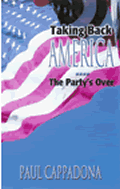IF
WE DON'T LEARN FROM HISTORY...
PART 2 of 2
By Marilyn Barnewall
November
28, 2008
NewsWithViews.com
In
the last article, we reviewed the protective devices put into place
by Congress to prevent the American people from going through another
Great Depression.
We had The McFadden Act, the Glass Steagall Act, and Regulation Q. These
were key pieces of legislation. They prevented interstate branch banking,
commercial bank involvement in investment banking and insurance products
(other than credit life), and kept long-term mortgage lending out of
commercial banks and in the savings and loans. The last article told
us that to gain access to deposits to fund mortgage lending, Regulation
Q permitted savings and loans to pay 25 basis points more on savings
and time deposits than commercial banks could pay.
As our ancestor legislators saw it in the 1920s and 30s, the lack of
these protections were a primary cause of the Great Depression.
Please keep some definitions in mind as we go through the structure
of the financial services industry. Until the Gramm-Leach-Bliley Act
of 1999, a commercial bank made business and consumer loans and issued
credit cards. Commercial banks were unable to sell investment or insurance
products (thanks to Glass Steagall) and investment banks could not take
deposits.
The sub-prime mortgage mess began with the Community Reinvestment Act
of 1977. I wrote long ago that this law was the cause of sub-prime mortgages
and it is pretty well agreed that I was right. CRA required commercial
banks to stop “redlining.” What is “redlining?”
It is refusing to make loans in communities where there is a high crime
rate, high unemployment, poor credit history, and, generally, where
real estate values are unstable and people cannot repay large home loans
over thirty years because of all the problems in their community. More
about CRA later…
The first big change in banking was the Depository Institutions Deregulation and Monetary Control Act. This Act passed the Congress in 1980. It gave the Federal Reserve more control over non Federal Reserve banks. Not all banks are members of the Federal Reserve. This is the law that helped cause the failure of the savings and loan industry in the mid-to-late 1980s. The primary damage was done by removing the restraints exercised by the Federal Reserve Board of Governors under Glass Steagall.
By the early 1980s, Merrill Lynch was offering Cash Management Accounts. These accounts paid high rates of deposit interest – as I recall, up to 21 percent at one time. That sounded great to consumers. Well, it sounded great to get 21 percent interest on a deposit account until so much money was taken from commercial banks and savings and loans that it caused “disintermediation.”
For an accurate definition, I suggest you use a dictionary. It means money was flowing out of one industry into another one… in this case, from commercial banks and savings and loans into investment brokers (now called “banks” – which they are not).
In other words, 21 percent interest is great – unless jobs are lost because businesses can’t borrow from banks with no money to lend (because deposits are sitting in a high interest rate account with a stock broker… who does not make loans to businesses or consumers. The 21 percent interest was great – until mortgage loan interest rates went into double digits because savings and loans had no money to loan… their deposits were also going into brokerage money market accounts. The 21 percent was great until car loans had such high interest rates on them that no one purchased new cars and jobs were lost. This occurred in the early 1980s.
At the time all of the banking deregulation was passing through Congress like castor oil through an infant, the Congress had a choice. It could give investment banks permission to offer interest-bearing deposit accounts but live with the same restrictions Regulation Q placed on banks and savings and loans. Or, it could eliminate Regulation Q and allow the investment banks to pay whatever rates of deposit interest they wanted.
Now, anyone with an IQ two points above plant life understands that if consumers can get 21 percent from a Merrill Lynch money market account or 5 percent from a commercial bank or 5 ½ percent from a savings and loan, the consumer is going to go for 21 percent. So, it should have been no surprise to any thinking person that disintermediation would occur. But, shock of shocks, when the prime borrowing rate at commercial banks reached 15 percent and more, when the home mortgage rate at savings and loans entered double digits, Congress – which had caused the problem to begin with – decided it definitely had to do something about this dastardly situation. So, it did away with Regulation Q. Banks and savings and loans quickly raised their rates of deposit interest to regain the lost deposits back into their institutions.
Why was the cost of funds so high at banks and savings and loans? Because. They had to compete with Merrill Lynch to get deposits from consumers. Everyone was putting money into brokerage money market accounts to gain the rewards of high interest deposit accounts. The cost of funds was, at the time, determined by the cost of deposits. If a bank paid zero percent for checking account money and 5 percent for savings, the average cost of funds (on which the primer rate was determined) was from 3 to 6 percent. During this time frame, the prime lending rate was close to 20 percent. The high deposit rate costs were a direct result of Congress and legislation designed, it appears, to destroy the savings and loan industry. It was designed to make Freddie Mac and Fannie Mae the primary source of mortgage money for home ownership in America.
I’m sure it was just an accident that Fannie and Freddie happened to be the catalyst that caused the current financial crisis in America.
Is the current financial services crisis sounding a bit like a well-crafted plan to you yet? Having been a banker for many years, it sure sounds that way to me.
The Garn-St. Germain Act was passed so savings and loans could be “saved.” They were deregulated. This is how the secure mortgage source for American home buyers was destroyed. Savings and loans could now make commercial business loans and consumer home repair and car loans heretofore only available at commercial banks.
One unfortunate part of the entire mess: Consumer and business lending is a specialized area, quite different from making mortgage loans. The computer systems in place at savings and loans could not provide reporting data required by law. They made bad loans, were unable to comply with consumer protection laws and regulatory reporting requirements, and did not properly maintain control of commercial loans (let alone evaluate their credit worthiness).
Surprise, surprise! They failed.
So, we lost our source of stable mortgage lending when the Congress passed laws that caused the savings and loan industry to fail. And, it was unnecessary. But no one really noticed because Freddie and Fannie picked up the slack.
How many people today would be delighted to receive the 5.50 percent deposit interest rate that savings and loans paid to maintain sufficient deposits to finance mortgages? Of course, the fact that today we only get one or two percent on large time deposits is a total accident. The Congress didn’t know any better… or, did they?
At the same time the savings and loans were dealing with a lose/lose financial services environment created by Congress, they were also having to fight for business profits with Fannie Mae and Freddie Mac. These two government sponsored entities (GSEs) had access (from the government, of course) to lower cost funds and they made lower cost mortgages available to people… especially people who could not afford to repay the loans. Commercial banks, you see, are audited at least once annually. Any bad loans they made were tracked. The auditing procedures at Freddie and Fannie were… criminal is a word that comes to mind.
Goodbye savings and loans.
The rest of the Glass-Steagall Act disappeared in 1999 when the Gramm-Leach-Blily Act was passed. It enabled commercial and investment banks to consolidate. Citigroup, one of the “Big 9” currently in financial hot water, merged with Travelers Group (Insurance) in 1998. They combined banking and insurance underwriting services. The Glass Steagall Act had prevented the combining of insurance and securities companies. Gramm-Leach-Blily allowed commercial banks to speculate… also heretofore prevented by Glass Steagall.
The end of the story cannot be made to sound pretty. None of it is pretty. It is not only ugly, it is evil.
The laws we had on the books from the 1930s through the 1970s kept America’s commercial banks strong. Having independently owned savings and loans that were not in any way government sponsored entities kept the mortgage market strong and real estate prices increased at reasonable rates every year. Investment banks did not offer commercial banking products and so could be intelligently regulated and monitored by the Securities and Exchange Commission… which hasn’t got a clue about how to audit lending portfolios.
Combine all of the above with an increasing philosophy within the commercial banking industry to use risk elimination loan policies and the logical result is the financial mess in which this country finds itself today.
Capitalism requires a banking system – a financial system – based on risk management. When financial risk is removed, it results in socialism. And, my friends, that is the new door through which we are about to walk.
At this point in time, the U.S. government owns 80 percent of personal real estate investments… on any home with a mortgage. It holds that ownership because it owns Freddie Mac and Fannie Mae. Any mortgage written by Freddie and Fannie is now owned by the U.S. government. That’s called socialism, too.
Government has purchased a primary position within the insurance industry with funds “loaned” to AIG, one of the biggest insurers in the world.
In a novel I wrote recently, the female bank consultant tells two friends who are trying to figure a way out of the financial crisis they see coming (in 2006) that when the U.S. dollar fails, it was altogether possible that they government would put up as collateral all of the personally-owned real estate in America. The International Monetary Fund would require such collateral to make a loan bit enough for America to buy its way out of international debt.
At the time I wrote it, I thought it was a stretch relative to believability. But, I made twelve predictions about what financial crises were coming… and so far ten of them have come true.
|
Subscribe to the NewsWithViews Daily News Alerts! |
So… I have removed myself from the category of “conspiracy nut” and placed myself firmly into the “I’m not crazy, you are” category by comparison to those who think government can solve the problems government created. I’m not a conspiracy nut because I do not believe in the “too big to fail” theory, either. Being too big is what has caused much of the financial institution failure.
It makes not sense to think that making too big institutions bigger will solve a problem that being too big caused.
I rest my case. For part one click below.
Click here for part -----> 1,
� 2008 - Marilyn Barnewall - All Rights Reserved











